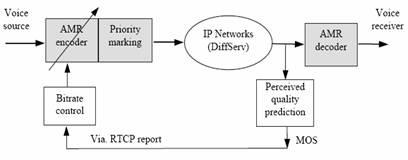Developing an improved quality of service control technique for voip
The two important modules in Fig.1 are the bit-rate control module at the sender side and the perceived speech quality prediction module at the receiver side. Approximately, every 5sec (the time interval between RTCP reports), the perceived speech quality (i.e. MOS score) is predicted from network parameters (e.g. packet loss and delay) by a combined PESQ (Perceptual Evaluation of Speech Quality)/E-model based method [3].
The bit rate control module is used to adapt the sender bit rate in accordance to the feedback information. The basic idea is that the AMR codec can reduce its bit-rate (if possible) when there is network congestion and increase its bit-rate when no congestion is detected. The predicted MOS score is compared with the existing MOS and the controller will choose the best step to change or keep existing AMR rate.
2. Priority marking QoS control scheme
In rate-adaptive QoS control scheme, it is assumed that all the packets within a flow are equally important. Previous research [3] has shown that some speech segments are more important than others. This phenomenon has been proven to exist for codecs such as G.729, G.723.1 and AMR [4]. This forms the basis for the priority marking control scheme as shown in Fig.2. Each speech frame is marked differently depending on whether it is perceptually important or not. For example, the priority-marking module marks the beginning of a voiced segment (e.g. the first 5 or 10 frames of a voiced segment for the AMR codec) as high priority (e.g. marked as a ‘premium’ class), while others are marked as perceptually unimportant (e.g. marked as a ‘best-effort’ class). When there is network congestion, the perceptually unimportant frames have a higher drop probability. This protection scheme results in a lower loss probability for packets with high priority and can lead to a better perceived QoS compared to no-control scheme.

Fig.2: Priority marking QoS control scheme
3. Combined rate-adaptive and priority marking QoS control scheme
As discussed above, the rate-adaptive QoS control scheme is based mainly on an objective MOS score at the receiver and packet loss contributed significantly to the measured or predicted MOS score. To reduce the long delay caused by simple over buffered drop tail queue, the network operators commonly use the RED (Random Early Detection) queue or a similar queue management method to provide a better congestion notification and control [5]. The use of RED queue method in the system makes it logical to try to link send rate adaptive control with packet priority marking because it is relatively easy to set different queues or virtual queues in a RED queue management system to provide different treatment for different priority packets.
Priority marking should reduce the loss or delay of important packets. An important goal is to investigate whether the overall perceived speech quality can be improved further by combining rate-adaptive and priority marking control schemes. This is the motivation of the proposed combined QoS control scheme, which is shown in Fig.3.

Fig.3: Combined QoS control scheme.
As shown in Fig.3, the bit rate of the AMR codec is adjusted in accordance with the objective, predicted MOS, and, at the same time, the perceptually important segments of speech are protected by priority-marking. Potentially, this should make it possible to optimize the perceived speech quality for VoIP applications using AMR codec.
The main objective of this research is to investigate the possibility of combining rate adaptation control technique with priority marking, to exploit the advantages of the two approaches to provide a robust control scheme which delivers optimum QoS in terms of voice quality. In rate control schemes, the cost of adapting the data flow to changes in the network is that some packets may be dropped randomly when congestion occurs and this will increase the packet loss rate. However, in priority marking schemes important packets are dropped less and delayed less. Thus, the combined scheme should provide improved overall user perceived quality.